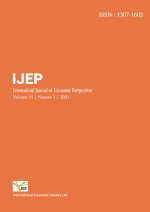Development of school adjustment scale
Keywords:
development, scale, school adjustment, secondary school studentsAbstract
In this study, School Adjustment Scale has been developed for Secondary School Students. This School Adjustment Scale consists 70 items at initial stage, under five dimensions. In the present study, Researcher had used purposive sampling. The sample consists of 100 Secondary School Students were selected from the Lucknow District. Final Draft consist of 28 items.
References
Amerta, I. M. S., Sara, I. M., & Bagiada, K. (2018). Sustainable tourism development. International research journal of management, IT and social sciences, 5(2), 248-254.
Bagudu, H. D., Khan, S. J. M., & Roslan, A. H. (2016). The impact of microfinance institution on development of small and medium enterprises: a case study of lagos state. International research journal of management, IT and social sciences, 3(9), 95-106.
Baker, J. A. (2006). Contributions of teacher–child relationships to positive school adjustment during elementary school. Journal of school psychology, 44(3), 211-229. https://doi.org/10.1016/j.jsp.2006.02.002
Best, J. W., & Kahn, J. V. (2016). Research in education. Pearson Education India.
Birch, S. H., & Ladd, G. W. (1997). The teacher-child relationship and children's early school adjustment. Journal of school psychology, 35(1), 61-79. https://doi.org/10.1016/S0022-4405(96)00029-5
Buhs, E. S. (2005). Peer rejection, negative peer treatment, and school adjustment: Self-concept and classroom engagement as mediating processes. Journal of School Psychology, 43(5), 407-424. https://doi.org/10.1016/j.jsp.2005.09.001
Costenbader, V., & Markson, S. (1998). School suspension: A study with secondary school students. Journal of school psychology, 36(1), 59-82. https://doi.org/10.1016/S0022-4405(97)00050-2
Knight, G. A. (1997). Cross-cultural reliability and validity of a scale to measure firm entrepreneurial orientation. Journal of business venturing, 12(3), 213-225. https://doi.org/10.1016/S0883-9026(96)00065-1
Lokesh, K. (1984). Methodology of educational research. Vikas publishing house.
Mangal, S. K. (2002). Advanced educational psychology. PHI Learning Pvt. Ltd..
Mangal, S. K. (2012). Advanced Educational Psychology, PHI Learning Pvt.
McCabe, S. E., Boyd, C. J., & Young, A. (2007). Medical and nonmedical use of prescription drugs among secondary school students. Journal of Adolescent Health, 40(1), 76-83. https://doi.org/10.1016/j.jadohealth.2006.07.016
Nelson, B., Martin, R. P., Hodge, S., Havill, V., & Kamphaus, R. (1999). Modeling the prediction of elementary school adjustment from preschool temperament. Personality and individual differences, 26(4), 687-700. https://doi.org/10.1016/S0191-8869(98)00174-3
Noordin, T. A., & Sulaiman, S. (2010). The status on the level of environmental awareness in the concept of sustainable development amongst secondary school students. Procedia-Social and Behavioral Sciences, 2(2), 1276-1280. https://doi.org/10.1016/j.sbspro.2010.03.187
Pigott, R. L., & Cowen, E. L. (2000). Teacher race, child race, racial congruence, and teacher ratings of children's school adjustment. Journal of School Psychology, 38(2), 177-195. https://doi.org/10.1016/S0022-4405(99)00041-2
Sasser, T. R., Bierman, K. L., & Heinrichs, B. (2015). Executive functioning and school adjustment: The mediational role of pre-kindergarten learning-related behaviors. Early childhood research quarterly, 30, 70-79. https://doi.org/10.1016/j.ecresq.2014.09.001
Singh, A. K. (1986). Tests, measurements and research methods in behavioural sciences. Tata McGraw-Hill.
Singh, B., & Sharma, R. A. (2015). Plant terpenes: defense responses, phylogenetic analysis, regulation and clinical applications. 3 Biotech, 5(2), 129-151.
Trzepacz, P. T., Baker, R. W., & Greenhouse, J. (1988). A symptom rating scale for delirium. Psychiatry research, 23(1), 89-97. https://doi.org/10.1016/0165-1781(88)90037-6
Published
How to Cite
Issue
Section
Copyright (c) 2021 Huma Naz, E. Ahmad

This work is licensed under a Creative Commons Attribution 4.0 International License.
Allows users to: distribute and copy the article; create extracts, abstracts, and other revised versions, adaptations or derivative works of or from an article (such as a translation); include in a collective work (such as an anthology); and text or data mine the article. These uses are permitted even for commercial purposes, provided the user: gives appropriate credit to the author(s) (with a link to the formal publication through the relevant URL ID); includes a link to the license; indicates if changes were made; and does not represent the author(s) as endorsing the adaptation of the article or modify the article in such a way as to damage the authors' honor or reputation. CC BY







